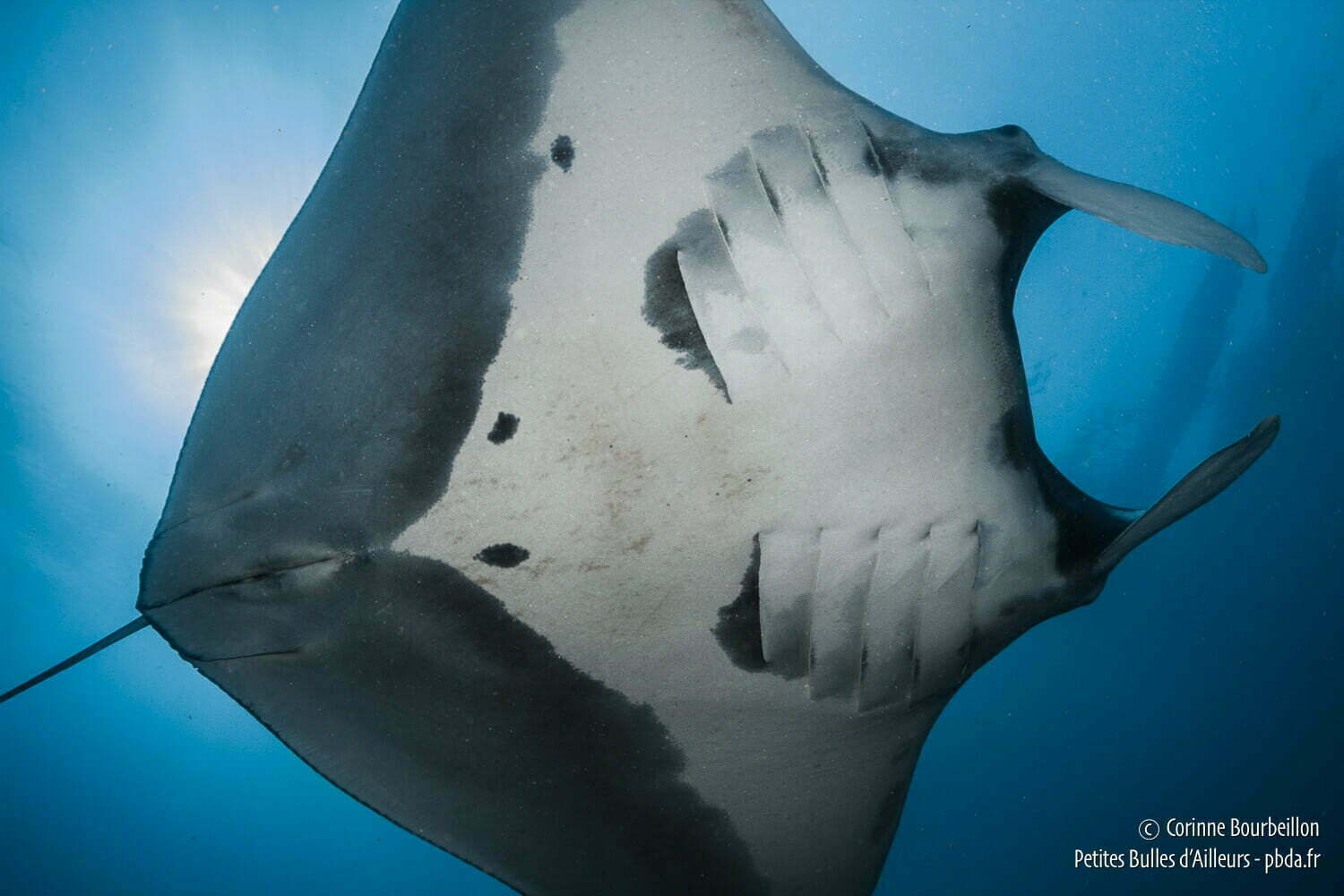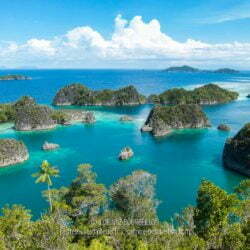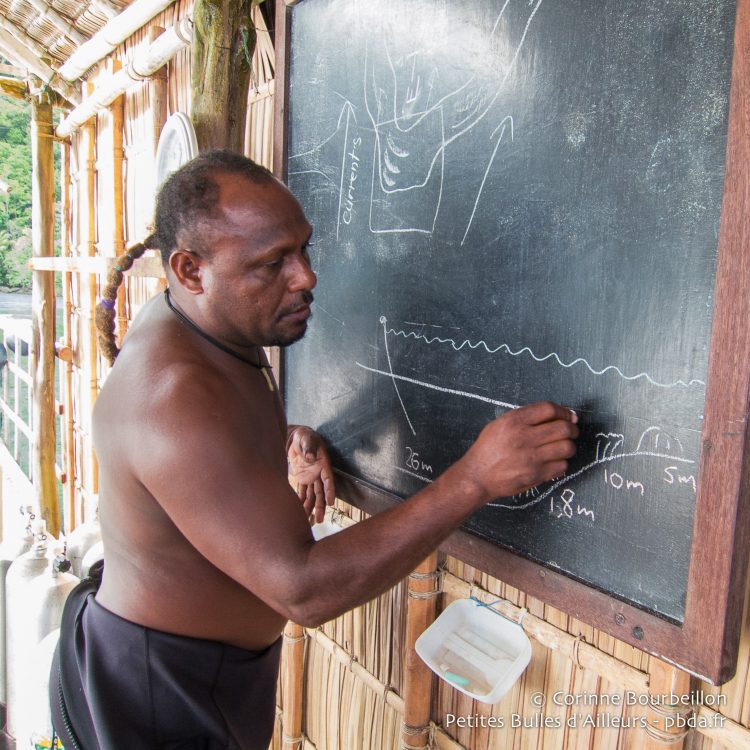Indonesia: Raja Ampat - January 2015
Dear English-speaking readers, this page is an automatic translation of an article originally written in French. I apologise for any strange sentences and funny mistakes that may have resulted. If you read French, click on the French flag below to access the original, correct text:
The site is called Blue Magic. This isolated reef in the open sea is frequented by manta rays in season. It is one of my favorite diving spots in Raja Ampat (West Papua, Indonesia).
Mantas!
January 25, 2015. That day, I am the only diver on the boat. I am with my super papuan guide Otto Awomwho supervises the dives at Sorido Bay Resort in Papua Diving. For the underwater photographer that I am, this is the ultimate luxury. Dives a la carte and private guide! I feel super-princess... 🤗
The end of my stay is approaching and I asked to return to Blue Magic. Every dive at this well-named site is a festival - humpback parrotfish, barracudas, schools of jacks - and every dive is different from the last.


When we arrive in the area, Otto scans the water for the top of the reef, which is about 12 meters deep at high tide. "Mantas!" He launches.
I look at the water too. I am hallucinating. We see very clearly the dark diamonds of several large manta rays. We are the only boat in the area, the only divers. No other boat could scare away the beautiful giants. So we have good chances to admire the manta rays under water...
We decided not to do the deep part of the reef (25-30 meters) that we usually explore at the beginning of the dive, to go directly to the top (around 12 meters deep) since the huge manta rays seem to be in the mood to hang out there that morning...
Good shot! We spent more than an hour underwater with manta rays. Here is a small summary in 1 minute 30 of video:
Current and plankton
At the top of Blue Magic that day (as often), there is a crazy current. And we can see it well on my little video, the visibility is not extraordinary, the water is full of plankton. But when there is both current and plankton, it is often the guarantee of beautiful encounters!
Considering the conditions, I am very happy to be with Otto Awom, who is probably the best connoisseur of the underwater world of the Dampier Strait, in Raja Ampat. He is among the first to have explored them, about twenty years ago, with Max Ammer, before the development of diving tourism in the region.
At Blue Magic, as on all the other sites, Otto knows perfectly well how to evaluate the direction and the strength of the current, in order to guide the boat's captain so that he drops us at the right place for the launch: that is to say, a little bit off the site but not too much either, the objective being not to miss the reef during our descent by drifting.
Underwater, we arrive right where we should, on the side of the reef, close to the top. After a few minutes of waiting, in the middle of silver schools of jacks and purple clouds ofanthias wriggling, the majestic manta rays make their appearance!

An hour with the mantas
I fixed myself to the reef with my hook to avoid having to fight against the current, but I am badly positioned to enjoy the show (and incidentally to film and take pictures). I float like a small flag, held by my line fixed to the front of my stab (the Vest-stabilizer divers, for the uninitiated). In short, not at all in the right direction... the manta rays arrive on the side of my fins. I have to contort myself to point my lens towards them. Exhausting and inconvenient.
Otto stays a little away, to let me make my pictures quietly. He shows me with his finger a coral spatula a little above, in the middle of the high part of the reef and closer to the trajectory of the manta rays.
I unhooked myself and managed to progress until there. There is sand and dead coral debris at the foot of the huge potato, I can settle there. There, I am sheltered from the furious flow of the current, which breaks on both sides of my refuge. I can finally stay turned on the right side without getting exhausted and settle down almost comfortably, with my back to the rock, well in front of the sea giants.
They quietly run upstream, mouth open to swallow a plankton, slowly spinning over the coral to get clean skin by small fish that swarm.
They seem to glide effortlessly and do one flight after the other, not caring about our presence. They sometimes pass very close, above our heads, it seems that they like to feel our strings of bubbles caressing their bellies.
We will spend more than one hour to observe them, without moving. I counted about ten of them. These gigantic stingrays have a wingspan of 4 to 5 meters, maybe more. I am fascinated. They are both imposing and graceful.
I'm in a better position than before to admire them, but the conditions haven't changed and it's really not ideal for filming or photographing.
I am against the light, in a loaded water, and I can hardly leave my protective coral pad to try to approach gently the manta rays in order to get a better picture. The current would take me away immediately and it would be impossible for me to come back to the reef with the strength of my fins...
So I have to be patient and wait for them to come to me to hope to get one or two good images. The time to switch from video to photo mode, and vice versa, I miss a lot of opportunities and pester my regulator...
When the mantas are too far away, my flash only catches the particles in suspension and the small fish wriggling in the foreground. When they are too close and come to rub their belly on my bubbles, they "overflow" the frame, despite my wide angle. Super annoying. 😂

What about Manta Sandy?
On the top of Blue Magic, the situation is much less comfortable than at another famous site of Raja Ampat for manta ray observation, called Manta Sandy (near Arborek Island), where you are wedged at the bottom on the sand to admire the mantas. This site is shallow, even snorkelers can enjoy the show.
Manta rays are very common in Manta Sandy and are more numerous during a season that goes roughly from October-November to March-April. They swim above a cluster of coral spats on a sandy bottom, which are populated by small cleaning fish.
I had attended a fantastic carouselthree years earlier. I give you the video I made in 2012 below:
Manta Sandy is considered as THE manta spot of the Dampier Strait. I went back there, during this new stay in 2015, but I was less lucky than three years ago. I did not fall at such a good time - there was not much current - and I only saw a few mantas passing by this time... Disappointing compared to what I was hoping for. But other divers assured me that they had seen, a few days earlier, a spectacular ballet.
Nature is like that, nothing is ever guaranteed, even in Raja Ampat. This year, it was at Blue Magic that I experienced my most beautiful encounter with mantas!
Ultimate reward: for my last day, we went once again to Blue Magic. And at the very end of the dive, as we were going back up to the top of the reef, Otto and I came across giant mantas again... This time, we couldn't stay with them for long - we had no more air left.
Emmanuel, another diver who was with us that day, but who followed a different route underwater with another guide, was not so lucky. Not rancorous, he sent me the pictures he shot on the boat when we came back and with which I had fun to edit a mini "teaser", posted a few days ago on the Facebook page of Petites Bulles d'Ailleurs :
Thank you Emmanuel for this little souvenir film! For once I'm in front of the camera. What do you want... Mantas make me happy.
????
Some links
→ For the defenders of nature: the mantas are part of the threatened species, I refer you to the sites of the NGO Mantatrust (in English) and the association Longitude181 (in French) to know more
→ For fans: All my articles about manta rays
→ For pragmatists: Practical information to organize your trip to Raja Ampat
→ For enthusiasts: All articles on my trips to Raja Ampat











